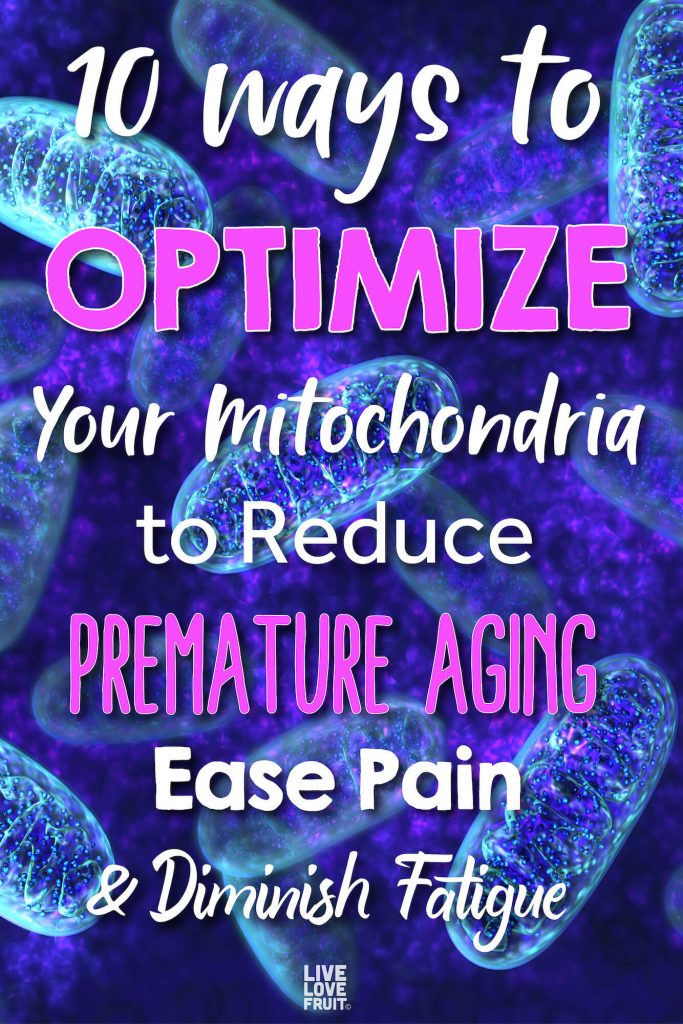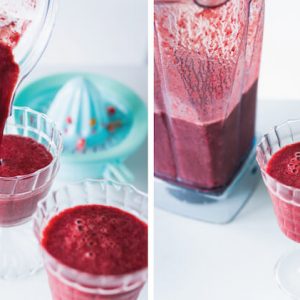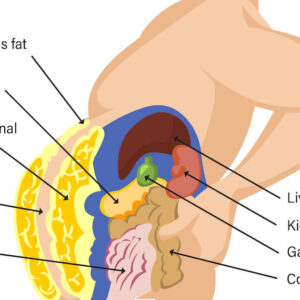
Are you feeling wiped out, exhausted, or chronically fatigued? The state of your mitochondria might have something to do with it. In fact, most people don’t know that mitochondria play a huge role in their energy levels, how well their metabolism functions and even how much brain fog they deal with every day.
Mitochondrial biogenesis, the act of generating new mitochondria to reduce premature aging, ease pain and diminish fatigue, is possible, but getting there takes a little bit of work on your behalf.
When we’re young, we have plenty of mitochondria. Think about all the energy children have, running around, screaming, and generally just their ability to go forever. But, as we get older, our mitochondria decline in both size and number, and unfortunately, our energy does too.
The good news is, is that we do have some control over how fast our mitochondria age and die out. Some foods also contain compounds that help reverse cellular gaining by activating genes that stimulate mitochondrial biogenesis.
But first, let’s talk a little more about what the powerhouses of our body actually do.
What are Mitochondria?
Mitochondria are the powerhouses of our cells. They’re what keep us running, helping turn energy from the food we eat into energy that the cell can use (a process called oxidative phosphorylation).
In the matrix of mitochondria the reactions known as the citric acid or Krebs cycle produce a chemical called NADH. NADH is used by enzymes embedded in the mitochondrial inner membrane to generate adenosine triphosphate (ATP). In molecules of ATP, energy is stored in the form of chemical bonds. When these chemical bonds are broken, the energy can be used (1).
Aside from energy production, mitochondria also carry out other important tasks.
They are essential in the process of apoptosis or cell death. Mitochondria actually help decide which cells in our body should get destroyed. Once the decision has been made, mitochondria release cytochrome C, which activates caspase, a major enzyme involved in destroying cells during apoptosis.
Mitochondria also regulate calcium stores in the body. Because this mineral is so critical, mitochondria quickly absorb calcium ions and hold onto them until they are needed. Calcium is required for a variety of processes in the body like neurotransmitter release, muscle function, fertilization, blood clotting, hormone signaling and more.
Another function of mitochondria is their ability to warm us up. When we are cold, we shiver to keep warm, but heat can be generated in other ways. One of these ways is utilizing brown fat stores. Brown fat tissue is highly concentrated in mitochondria compared to other cells and tissues of the body. During a process called proton leak, mitochondria generate heat (called non-shivering thermogenesis). Brown fat is highest in babies, as they are more susceptible to the elements. These levels slowly reduce as we age.
Oxidative Stress, Aging and Mitochondria
Mitochondria rank highest among the structures most vulnerable to destruction from oxidative damage. This is due to two reasons (2):
- They are exactly where free radicals are produced
- They lack the antioxidant defenses that are present in other parts of the cell
Mitochondria have a couple of ways of generating ATP. The most efficient method, called oxidative phosphorylation (OXPHOS), generates some amount of free radicals as a natural byproduct. These free radicals are most likely to damage that mitochondrion.
The difference between mitochondria and other intracellular compartments is that the mitochondria have their own DNA. As free radicals are generated by mitochondria as a byproduct of OXPHOS, they damage the structure of the mitochondria itself, as well as mitochondrial DNA. There is strong evidence to suggest that accumulated DNA damage in mitochondria is directly related to aging metabolic disorders and diseases (3).
The damage that happens inside mitochondria is one of the main factors of aging (which brings upon symptoms like increased pain, fatigue, and all the other wonderful things that happens to a body as its mitochondria degrade).
This damage inflicted on mitochondria may not be enough to kill them, but it is enough to disrupt their normal function. Dysfunctional mitochondria send incorrect messages, decrease ATP production, and produce even more free radicals. These defective mitochondria replicate their own damaged DNA into new mitochondria, eventually displacing all well-performing mitochondria.
Mitochondrial dysfunction caused by oxidative damage due to free radicals is a primary cause of age-related decline, as well as the pathologies associated with aging like Alzheimer’s disease, Parkinson’s disease and cancer (4, 5, 6). Not to mention the effects that oxidative stress has on our skin, and its ability to heal and regenerate.
In one revealing study, a team of researchers showed that muscle tissue of a 90-year-old man contained 95% damaged mitochondria compared to almost no damage in that of a 5-year-old (7). When you compare the two (think: the boundless energy of a child and the fatigued 90 year old), it becomes instantly apparent that mitochondrial degradation has a devastating impact on our bodies.
Factors That Lead to Mitochondrial Damage
So what increases the rate of oxidative damage to our mitochondria? Aside from basic energy metabolism required for the maintenance of the organism, environmental factors like exposure to pollution (smoke, poor air quality), pesticides, herbicides, chemicals and even stress, all determine the continuous generation of oxygen radicals.
Increased generation of oxygen radicals contributes to aging, but so does the reduced ability of our bodies to eliminate these free radicals (aka. reduced antioxidant mechanistic function).
Not just generation of oxygen radicals increase aging, but the decrease in the ability to eliminate these radicals (antioxidant mechanisms) also play a part. There is still discussion regarding the apparent decrease in antioxidant mechanisms during aging. Studies have found that animals treated with antioxidant therapy can effectively, nonspecifically protect against various causes of early mortality (8).
The protective effects of antioxidants on the human race can have great implications for the future as exposure to radiation and toxic compounds will sky-rocket over the next century (unless we actually smarten up and do something about it).
Mitochondrial Biogenesis
You might feel like you’re out of luck when it comes to regenerating and supporting your mitochondria, but that isn’t the full truth. While much of the focus out there today is on how we can protect and improve mitochondrial function, we don’t hear much about mitochondrial biogenesis.
Mitochondrial biogenesis is quite literally the generation of new mitochondria. Studies have found that calorie restriction and exhaustive physical activity stimulate this phenomena, but up until recently, there wasn’t a nutrient or other compound that could easily be taken to ensure that mitochondrial numbers remain high and healthy.
But now, science has revealed how one compound, pyrroloquinoline quinone or PQQ, can safely induce mitochondrial biogenesis without having to starve yourself, or exercise until complete exhaustion. And while intermittent fasting and exercise can definitely help improve the state of your mitochondria, if you’re one of those people who simply doesn’t have time for that – you’ve got options. We’ve all got options. So let’s take a look at the best ways you can optimize your mitochondria below.
10 Ways to Optimize Your Mitochondria
There are many things we can do to protect and improve the function of existing mitochondria, as well as certain nutrients we can focus on to enhance mitochondrial biogenesis. Mitochondria are very sensitive to damage, so protecting and supporting them is an important step in slowing down aging and protecting against age related diseases such as cancer and heart disease.
Fatigue, memory problems, pain and accelerated aging are a key sign your mitochondria are struggling.
Here are just a few recommendations that’ll not only jump start your mitochondria, but will quite literally improve the way you look and feel.
1. Pyrroloquinoline quinone (PQQ)
PQQ plays a critical role as an ultra-potent antioxidant that provides extraordinary defense against mitochondrial decay. The chemical structure of this compound allows it to withstand exposure to oxidation up to 5,000 times greater than vitamin C (9).
The most exciting news on PQQ emerged in early 2010, when researchers found that it not only protected mitochondria from oxidative damage, but it also stimulated growth of new mitochondria (10).
PQQ is found abundantly in the plant-food world, and is even present in human milk. But since humans are not capable of synthesizing PQQ, researchers have had to classify it as an essential nutrient (just like vitamins A, C, E, D and K).
When deprived of PQQ, animals exhibit stunted growth, compromised immunity, impaired reproductive capacity as well as fewer mitochondria in their tissue (11). When introduced back into the diet, PQQ reverses these effects, restoring systemic function, while increasing mitochondrial number and energy efficiency.
But how does PQQ generate new mitochondria? Via three separate mechanisms (12):
- PQQ increases expression of peroxisome proliferator-activated receptor gamma coactivator 1-alpha (PGC-1α). This molecule is a “master regulator” gene that mobilizes your cells’ response to various external triggers. It directly activates genes that boost mitochondrial and cellular respiration, growth and reproduction (13).
- PQQ activates the signaling protein, cAMP-response element-binding protein or CREB. The CREB gene is essential during embryonic growth and development. This compound also stimulates the growth of new mitochondria (14).
- PQQ regulates a recently discovered gene called DJ-1. This gene is closely involved in cell function and survival. It has been shown to prevent cell death by combating intensive antioxidant stress. Brain health and function is also highly dependent on DJ-1. Damage to this gene has been conclusively linked to the onset of Parkinson’s disease and other neurological disorders (15).
With that being said, how do we get more PQQ in our bodies?
Aside from taking a high-quality PQQ supplement (which can be found here), you can also increase your consumption of foods that are rich in PQQ itself.
Here are just a few foods that are highly concentrated in this compound (16, 17):
– Fermented soy (if you choose this, opt for organic only)
– Parsley
– Green tea
– Papaya
– Kiwi fruit
– Spinach
– Green pepper
– Carrots
– Cabbage
– Sweet Potato
– Potato
– Broad Beans
– Bananas
– Celery (particularly when dehydrated)
2. Coenzyme Q10
Coenzyme Q10 (or CoQ10) is known to protect and improve the function of existing mitochondria in the body. CoQ10 not only supports the mitochondrial respiratory chain, but it also acts as a powerful antioxidant in mitochondrial membranes (18). CoQ10 is also concentrated in the organs that have the highest mitochondrial density (like our liver and muscles).
CoQ10 is the primary antioxidant the human cell provides to protect and support mitochondria. Without this molecule, the level of ATP that the mitochondria produce drops, the energy that is available to that tissue decreases, and dysfunction and health conditions can then develop.
CoQ10 is best sourced as a supplement, or you can find it in smaller amounts in foods like:
– Spinach
– Broccoli
– Cauliflower
– Lentils
– Green peas
– Sesame seeds
– Pistachio nuts
– Oranges
– Strawberries
– Avocado
3. Eat “Clean” Foods
Consuming foods that are organic and locally grown is best if you want to super-charge your mitochondria. Pesticides, herbicides, food additives and other chemical all increase the concentration of reactive oxygen species that degrade and “poison” your mitochondria.
Try to avoid highly processed foods (like frozen or packaged foods), and products with an ingredient list that you can’t pronounce. Opt for organic when possible, and steer clear of foods that are difficult to digest and absorb like wheat/bread products, un-fermented/non-organic soy, eggs, and dairy.
4. Medicinal Mushrooms
Mushrooms are full of antioxidants that may have anti-aging potential. They’re particularly high in ergothioneine and glutathione, two incredibly important antioxidants for the human body.
When the body uses food to produce energy, it also causes oxidative stress because some free radicals are produced. Replenishing antioxidants, then, can help protect against this oxidative stress (19).
What better way to replenish your antioxidant stores than to supplement with mushrooms!
One of the best mushrooms with the highest antioxidant values is chaga. But not just any chaga. You want to make sure that your chaga is wild.
You can easily purchase chaga tea to make yourself, but if you have a super busy life like me, and don’t have time to boil down chaga for 30 minutes, then you might want something a little easier to take.
Bear Medicine Chaga is one brand I’ve been utilizing for the last couple months, and I love it. It is water dissolvable, and harvested from Siberian Black Birch trees (meaning the antioxidant potential is outta this world). It tastes exactly like the tea tastes when made from scratch, except you don’t need to wait 30 minutes for it to dissolve. More like 5 seconds.
My love for this product runs deep, so I was able to get an exclusive coupon code for all my readers who purchase from them. If you use the code LIVELOVEFRUIT15, you’ll receive 15% off your order.
5. Reduce Pharmaceutical Medications
Pharmaceutical medications are also problematic when it comes to mitochondrial damage. According to a study published in the journal Molecular Nutrition Food Research, medications are a major cause of mitochondrial damage and disease (20).
Medications documented to induce mitochondrial damage include:
– Alcoholism medications (disulfiram)
– Anesthetics
– Angina medications
– Antiarrhythmic
– Antibiotics
– Antidepressants
– Antipsychotics
– Anxiety medications
– Barbiturates
– Cholesterol medications (statins)
– Chemotherapy medications
– Diabetes medications
– HIV/AIDS medications
– Epilepsy/Seizure medications
– Mood stabilizers
– Parkinson’s disease medications
6. Alpha Lipoic Acid
Alpha lipoid acid (ALA) also known as lipoic acid is naturally present in our mitochondria. Research has shown that lipoic acid counteracts aging by improving mitochondrial function and decreasing oxidative stress (21). It may reverse and protect against the destructive consequences of diabetes, obesity, heart disease, neurodegeneration and cancer.
Studies have even found that lipoic acid is a potent stimulator of mitochondrial biogenesis in adipocytes (fat cells), thus giving it potential therapeutic applications in obesity and diabetes.
You can find supplemental alpha-lipoic acid here.
7. Resveratrol
The natural antioxidant resveratrol, found abundantly in the skin of grapes, can improve mitochondrial function and induce cellular reprogramming. Researchers believe that the compound might be a treatment option for those with mitochondrial diseases.
One study investigated the effects of resveratrol in human skin cells (fibroblasts) from three patients with mitochondrial disease. Treatment with a low dose of resveratrol improved all the cells’ mitochondrial function, compared to placebo treatment. It also increased the efficiency of cellular programming (22).
While you can pump your body with resveratrol by consuming plenty of grapes and berries, you can also get it in a more highly concentrated form by taking a resveratrol supplement. That, or drink organic wine, but then you’re exposing yourself to alcohol, which has damaging implications for our mitochondria.
8. Magnesium
Given magnesium is required for over 300 biochemical reactions in the body it is no surprise that it would be needed for our mitochondria, too.
Oxidative stress damages our mitochondria, which dampens their ATP production. However, mitochondria do have the ability to repair damage done to them by using magnesium-dependent enzymes. If your magnesium levels are inadequate, then your ability to boost your mitochondria and help restore them will be dampened. Your oxidative capacity will also suffer because of a decline in the rate of repair of your existing mitochondria (23).
The soil our food is grown in is incredibly deficient in this mineral. I always suggest people take a magnesium supplement at night (300-400mg) as it helps relax, and can make you a bit tired. Always go with magnesium glycinate as it absorbs the best.
9. Focus on High-Antioxidant Foods
If you haven’t already noticed a pattern based on everything you’ve read so far, then you’d not be very surprised to hear that consuming plenty of high antioxidant foods should be number one on your list.
Foods that are high in antioxidants help counteract the harmful effects of oxidative stress, and work by protecting the delicate membranes of our mitochondria.
Foods that have the highest ORAC value (Oxygen Radical Absorbance Capacity), also have the highest levels of antioxidants.
Here is a list of foods, starting from the top, that contain the highest ORAC values:
– Cloves
– Chaga
– Sumac
– Cinnamon
– Sorghum
– Oregano
– Turmeric
– Acai berry
– Cocoa powder
– Cumin seed
– Maqui berry powder
– Parsley
– Basil
– Curry powder
– Sage
– Mustard seed
– Ginger
– Black Pepper
– Thyme
– Marjoram
– Goji berries
10. Fasting and Intermittent Fasting
Fasting is a great way to stimulate autophagy and mitophagy, the process of culling old, dysfunctional mitochondria. If you read earlier in the article, you’d understand why this is so important! Dysfunctional mitochondria that stick around actually age us, more than help us. By getting rid of old mitochondria, fasting encourages the growth of new ones.
This process of renewing your mitochondria plays a huge role in the prevention of many of the diseases we currently have no acceptable treatment — like diseases of excess growth (aka. cancer).
You can fast for 24-72 hours (start with 24 if you’re new to it), or intermittent fast instead. Intermittent fasting is when you don’t eat for a 16 hour window. For example, you finish eating at 7pm, and don’t eat again until 11am the next day.
Whatever you choose to do, giving your body a little rest in digestion is a crucial step in boosting the state of your mitochondria (and quite literally helping grow new ones!).









I have horribly painful foot neuropathy, I can’t live with my feet on fire, is there anything to help repair the nerves and natural pain killer???
I’m desperate. Thank you
Annette
Hey Annette – sorry, I have nothing on foot neuropathy, but here is a good article I found: https://www.healthline.com/health/peripheral-neuropathy-natural-treatments
I’m looking for something specific To emphysema in regards to nutrition and any other suggestions.
Thank you
Hey Mel – check out my lung posts here:
https://livelovefruit.com/parsnip-juice-stop-asthma-sinus-problems-wheezing-emphysema/
https://livelovefruit.com/3-ingredient-mullein-tea-clears-lungs/
https://livelovefruit.com/drink-to-cleanse-toxic-lungs-smokers/
https://livelovefruit.com/natural-remedies-for-cough-lung-infections-bronchitis/
HELLO, I HAVE FIBROMYALGIA,PMR,COPD. I HAVE BEEN CHRONICLY TIRED FOR YEARS, AND LOTS OF PAIN, I HAVE TRIED SO MANY PRODUCTS THAT NEVER WORK DO YOU THINK THESE CAPSULES WOULD WORK FOR ME? EVEN IT THEY JUUST REPAIRED SOME OF MY
MITOCHONDRIA I WOULD SETTLE FOR THAT. THANKS BETTY
Hey Betty – absolutely. I would definitely try giving some of these supplements a try! Our mitochondria need all the help they can get. It can sometimes take awhile for these nutrients to help rebuild our mitochondria, so I’d stick with them for a couple months before deciding if they are working for you or not.
Hi Carly,
It would be nice if you offered Canadian sources for nutrients mentioned in your articles instead of primarily imported products. Many items carried on Amazon.com are not available on Amazon.ca, and shipping and price differences make make these unrealistic options.
Thanks for the wonderful articles that you bring to us. You are on my ‘sure to read’ list!
Hey Ron, I know, it is difficult to find Canadian sources sometimes. I am a Canadian myself, and most of the time I just have to pay the extra price to get them over the border. You might be able to find supplements similar to these in a local health food store!